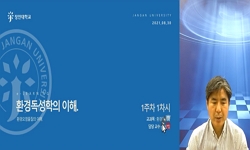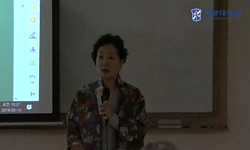황철석은 흔히 유비철석과 밀접히 공생하여 산출되므로 유비철석을 포함하는 황철석을 약광물로 이용할 때에는 비소의 독성에대한 세심한 주의가 필요하다 . 독성을 감소시키기 위해서는 ...
http://chineseinput.net/에서 pinyin(병음)방식으로 중국어를 변환할 수 있습니다.
변환된 중국어를 복사하여 사용하시면 됩니다.
- 中文 을 입력하시려면 zhongwen을 입력하시고 space를누르시면됩니다.
- 北京 을 입력하시려면 beijing을 입력하시고 space를 누르시면 됩니다.


유비철석을 함유하는 황철석 약광물의 수치 후 비소 제거효과 = The As-removal Effects of Pyrite Including Arsenopyrite after Process for Use in Medicine.
한글로보기부가정보
국문 초록 (Abstract)
그리고 850 o C 각각의 온도에서 가열하여 식초에 담금질하는 과정을 5 회까지 반복하였다 . 약재 내 유비철석은 450 o C
에서 초쉬법을 5 회 실시하여도 잔존하나 , 650 o C 에서는 초쉬법을 1 회 실시하면 완전히 제거된다 . 450 o C 에서 수치된 약재에서는 비소가 상당량 함유되어 있으나 , 650 o C 와 850 o C 에서 수치된 약재에서는 비소함량이 급격히 감소한다 . 약재 로부터 수용액으로 용출되는 비소 용출량이 가장 적은 수치조건이 가장 효과적인 수치법일 것임을 전제로 비소 용출 실험을 실시하였다 . 수용액내 비소의 용출량은 450 o C 에 서 가장 높고 , 650 o C 와 850 o C 에서는 급격히 감소한다 . 그러나
850 o C 에서 수치된 약재의 비소 용출량도 음용수 수질기준을 초과한다 . 수치온도가 높을수록 유비철석의 제거가 증대 되고 약재 내 비소함량과 비소 용출량이 감소하나 , 수치횟수의 효과는 뚜렷하지 않다 . 수치횟수 보다는 수치온도가 상대적으로 비소제거에중요한 요인이며 , 비소제거를 위해서는 650 o C 이상의 온도에 서 황철석을 수치하는 것이 필요하다 .
황철석은 흔히 유비철석과 밀접히 공생하여 산출되므로 유비철석을 포함하는 황철석을 약광물로 이용할 때에는 비소의 독성에대한 세심한 주의가 필요하다 . 독성을 감소시키기 위해서는 약재를 가열하여 식초에담금질하는 전통적 초쉬법을 적용하여 왔다 . 초쉬법의 과학적 효과를 검토하기 위해 유비철석을 포함하는 황철석 약재를 450 o C, 650 o C
그리고 850 o C 각각의 온도에서 가열하여 식초에 담금질하는 과정을 5 회까지 반복하였다 . 약재 내 유비철석은 450 o C
에서 초쉬법을 5 회 실시하여도 잔존하나 , 650 o C 에서는 초쉬법을 1 회 실시하면 완전히 제거된다 . 450 o C 에서 수치된 약재에서는 비소가 상당량 함유되어 있으나 , 650 o C 와 850 o C 에서 수치된 약재에서는 비소함량이 급격히 감소한다 . 약재 로부터 수용액으로 용출되는 비소 용출량이 가장 적은 수치조건이 가장 효과적인 수치법일 것임을 전제로 비소 용출 실험을 실시하였다 . 수용액내 비소의 용출량은 450 o C 에 서 가장 높고 , 650 o C 와 850 o C 에서는 급격히 감소한다 . 그러나
850 o C 에서 수치된 약재의 비소 용출량도 음용수 수질기준을 초과한다 . 수치온도가 높을수록 유비철석의 제거가 증대 되고 약재 내 비소함량과 비소 용출량이 감소하나 , 수치횟수의 효과는 뚜렷하지 않다 . 수치횟수 보다는 수치온도가 상대적으로 비소제거에중요한 요인이며 , 비소제거를 위해서는 650 o C 이상의 온도에 서 황철석을 수치하는 것이 필요하다 .
다국어 초록 (Multilingual Abstract)
Arsenopyrite completely disappeared when processed only once at 650 o C while it remained even after 5 processing cycles at 450 o C. Arsenic was most abundant in medicinal mineral samples processed at 450 o C and sharply decreased when processed at 650 o C or 850 o C. And arsenic extraction test in water was carried out from the processed pyrite medicine on the assumption that pyrite medicines with the lowest As metal content would be most desirable. Arsenic were most abundant in water extracted from medicinal mineral samples processed at 450 o C and sharply decreased when processed at 650 o C or 850 o C. But the extracted As concentrations in water exceeded drinking water standards even when processed at 850 o C. Increasing temperature promoted elimination of arsenopyrite and reduction of As in medicinal minerals and the extraction solutions. But the effects of processing cycles at the same processing temperature were not clear. Heating temperature is more important than number of processing cycles for the removal of arsenic, and it is necessary to heat pyrite to over 650 o C to remove it.
As pyrite is commonly associated with arsenopyrite, the use of pyrite including arsenopyrite for medicine requires close attention on arsenic toxicity. The toxicity was reduced by traditional processing operations include heating and quenching in vine...
As pyrite is commonly associated with arsenopyrite, the use of pyrite including arsenopyrite for medicine requires close attention on arsenic toxicity. The toxicity was reduced by traditional processing operations include heating and quenching in vinegar. To verify the scientific effects of this process, pyrite containing many crystals of arsenopyrite was processed at temperatures from 450 o C to 850 o C and through as many as 5 processing cycles.
Arsenopyrite completely disappeared when processed only once at 650 o C while it remained even after 5 processing cycles at 450 o C. Arsenic was most abundant in medicinal mineral samples processed at 450 o C and sharply decreased when processed at 650 o C or 850 o C. And arsenic extraction test in water was carried out from the processed pyrite medicine on the assumption that pyrite medicines with the lowest As metal content would be most desirable. Arsenic were most abundant in water extracted from medicinal mineral samples processed at 450 o C and sharply decreased when processed at 650 o C or 850 o C. But the extracted As concentrations in water exceeded drinking water standards even when processed at 850 o C. Increasing temperature promoted elimination of arsenopyrite and reduction of As in medicinal minerals and the extraction solutions. But the effects of processing cycles at the same processing temperature were not clear. Heating temperature is more important than number of processing cycles for the removal of arsenic, and it is necessary to heat pyrite to over 650 o C to remove it.
동일학술지(권/호) 다른 논문
-
임천 폐광산의 지하갱도와 인공차수막의 탐지를 위한 지구물리탐사
- 대한자원환경지질학회
- 김지수
- 2003
- KCI등재,SCOPUS,ESCI
-
서남 옥천변성대 옥천층군의 층서 및 암석화학에 대한 예비연구
- 대한자원환경지질학회
- 유인창
- 2003
- KCI등재,SCOPUS,ESCI
-
수자원의 수질과 오염에 대한 기반암의 영향 연구 : 통계학적 접근
- 대한자원환경지질학회
- 이병선
- 2003
- KCI등재,SCOPUS,ESCI
-
토양 정밀 조사에 의한 고로폐광산 주변 비소오염 토양 및 하천퇴적토의 오염도 평가 및 오염 토양 복원 규모 설정
- 대한자원환경지질학회
- 차종철
- 2003
- KCI등재,SCOPUS,ESCI
분석정보
인용정보 인용지수 설명보기
학술지 이력
| 연월일 | 이력구분 | 이력상세 | 등재구분 |
|---|---|---|---|
| 2023 | 평가예정 | 해외DB학술지평가 신청대상 (해외등재 학술지 평가) | |
| 2020-01-01 | 평가 | 등재학술지 유지 (해외등재 학술지 평가) |  |
| 2013-01-01 | 평가 | 등재 1차 FAIL (등재유지) |  |
| 2010-01-01 | 평가 | 등재학술지 유지 (등재유지) |  |
| 2008-01-01 | 평가 | 등재학술지 유지 (등재유지) |  |
| 2006-01-01 | 평가 | 등재학술지 유지 (등재유지) |  |
| 2004-01-01 | 평가 | 등재학술지 유지 (등재유지) |  |
| 2001-07-01 | 평가 | 등재학술지 선정 (등재후보2차) |  |
| 1999-01-01 | 평가 | 등재후보학술지 선정 (신규평가) |  |
학술지 인용정보
| 기준연도 | WOS-KCI 통합IF(2년) | KCIF(2년) | KCIF(3년) |
|---|---|---|---|
| 2016 | 0.35 | 0.35 | 0.34 |
| KCIF(4년) | KCIF(5년) | 중심성지수(3년) | 즉시성지수 |
| 0.29 | 0.27 | 0.625 | 0.19 |




 ScienceON
ScienceON 스콜라
스콜라






